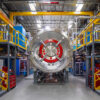Scientists at the University of Warwick have developed a handheld sensor using diamonds that could transform cancer detection.
Announced on Thursday, the new device traces tiny magnetic particles injected into the body, offering a non-toxic alternative to radioactive tracers and dyes. Researchers believe the innovation could improve both surgical outcomes and patient safety.
Metastasis, when cancer spreads from the original tumour, remains one of medicine’s greatest challenges. Doctors often examine lymph nodes, which filter harmful substances, to determine whether cancer has advanced. These results guide crucial decisions about surgery and follow-up care. Current techniques rely on radioactive tracers or dyes, which carry risks and are not available in all hospitals.
The Warwick team designed a highly sensitive sensor using diamonds measuring just half a cubic millimetre. The sensor works by identifying iron oxide nanoparticles in the tracer fluid. This magnetic fluid travels alongside cancer cells, showing whether they have reached the lymph nodes. In addition, the system removes the need for bulky electronics, allowing use in operating rooms.
Lead author Alex Newman, a PhD student in Warwick’s physics department, said the device could improve keyhole and endoscopic surgery. “There is a real demand for versatile non-toxic means of finding cancer,” he said. He explained that the sensor head measures only ten millimetres, small enough for surgical use. Furthermore, the device is highly sensitive, detecting one hundredth of the typical tracer dose.
The design uses a small permanent magnet alongside the diamonds. According to the researchers, this compact structure enables handheld use without large machines.
Read more: Breath Diagnostics opens Respiratory Innovation Summit with captivating presentation
Read more: Breath Diagnostics now offering a compelling investment opportunity
Clinicians often face complications with radioactive tracers
Professor Gavin Morley, who leads the group, said the breakthrough relies on nitrogen vacancy centres inside the diamond.
“These allow the diamond to detect very small changes in the magnetic field,” Morley said.
He noted that these centres also give diamonds a distinctive pink colour.
The medical potential is significant. Clinicians often face complications with radioactive tracers, which not every hospital can provide, or blue dyes, which can trigger allergic reactions. Stuart Robertson, a consultant breast cancer surgeon at University Hospitals Coventry and Warwickshire, said he already uses magnetic localisation in his work. He added that the new diamond sensor offers more advantages over traditional techniques.
Researchers believe the tool could extend beyond breast cancer. In addition, they see potential applications for lung, liver, colorectal and oesophageal tumours. The handheld device may make it easier for surgeons to track cancer spread during operations, improving decision-making in real time.
The scientists also see promise outside medicine. Professor Morley suggested uses in spacecraft technology and fusion power, where highly sensitive magnetic detection is valuable. Meanwhile, the research, published in Physical Review Applied, highlights how fundamental physics can advance clinical practice.
The Warwick team aims to continue refining the technology. Further trials will test its effectiveness across different types of cancer and clinical settings. If successful, the diamond sensor could change the way doctors detect cancer spread, replacing radioactive and dye-based tracers with a safer, more accessible method.
This is actually part of a wider market segment meeting demand for less invasive cancers detection methods than standard of care.
Read more: Breath Diagnostics pioneers novel lung cancer breath test
Read more: Breath Diagnostics takes aim at lung cancer with One Breath
Present standard of care is not without risks
Low-dose CT scans have become a standard of care for detecting several cancers, especially lung cancer.
The technology helps identify tumours early, often before symptoms appear. However, repeated exposure still carries some radiation risk, which can accumulate over time.
Additionally, false positives sometimes lead to unnecessary follow-up tests and anxiety. Beyond health concerns, the scans demand significant time and opportunity cost.
Patients often lose a full day to travel, waiting, and the procedure itself. For many, that means missed work, childcare disruptions, and added stress. Nonetheless, the benefits of early detection generally outweigh these risks and burdens.
Beyond CT scans, several emerging technologies promise less invasive cancer detection. Breath Diagnostics, for example, is developing OneBreath, a test that analyzes volatile organic compounds in a single breath sample. These compounds can reveal biochemical changes linked to cancer, providing a quick, non-invasive alternative to imaging.
Another option is the liquid biopsy, which detects tumour DNA or circulating tumour cells in a blood sample. Companies like Guardant Health (NASDAQ: GH) and Grail Inc (NASDAQ: GRAL) are advancing this method, offering real-time monitoring without surgery. In addition, elastography uses ultrasound or MRI to measure tissue stiffness, which can indicate tumours. Firms such as Siemens Healthineers (ETR: SHL) have integrated elastography into diagnostic platforms.
Fluorescence imaging employs light-sensitive dyes that highlight cancerous tissue during surgery, helping surgeons remove tumours more precisely. On the other hand, reflectance confocal microscopy allows non-invasive, high-resolution imaging of skin layers to detect early cancers. Caliber I.D. And Germany’s VivaScope lead developments in this space.
These alternatives reduce radiation exposure, shorten procedures, and may lower opportunity costs, offering patients safer and more efficient diagnostic paths.
.
joseph@mugglehead.com













